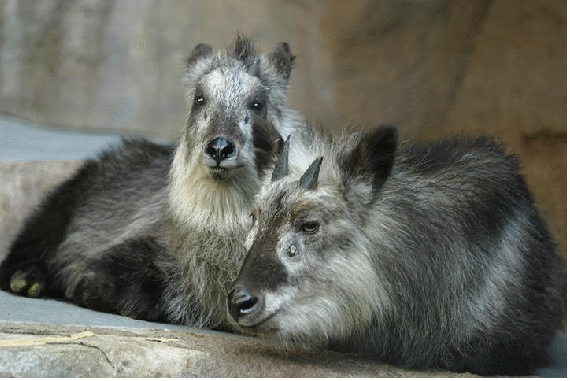Nihonnkamoshika is a kind of kamoshika. It is a endemic species in Japan. The scientific name is Capricornis crispus.
Nihonnkamoshika is Animalia Chordata Vertebrata Mammalia Cetartiodactyla Bovidae Caprinae Rupicaprini Capricomis C.crispus. Kamashika are classified in the ten species. It is nihonkamoshika, taiwankamoshika, gouraru, sumatorakamoshika, shiroiwayagi, syamoa, gourudentakin, saiga, zyakouushi, chiruu. Nihonkamoshika is similar to shika, but it isn’t a true shika. It is Bovidae.

Nihonkamoshika’s habitat space is mountain from a low mountain zone to subalpine of Honshu, Shikoku, Kyusyu in Japan. They don’t live in Chugoku district. They have become extinct west of Hyogo in Honsyu. Moreover it is different in body and color in its habitat space. Nihonkamoshika in Honshu is bigger than Shikoku. The number of Shikoku and Kyusyu is decreasing now. Nihonkamoshika in Shikoku live in only Kouchi and Tokushima. They are about 1300 head.
Nihonkamoshika is 30~45 kg weight. The shoulder height is 70~75 cm, the trunk is 70~85 cm. The horn is black and about 15 cm. It has a sharp point and curved to back. There are a lot of bkackish brown and grayish brown in body color. But there are differences among individuals. Nihonkamoshika have four stomach for rumination. Under the eye, they have remarkabl gland. They secrete from gland and marking. The fur doesn’t let water through and humidity retention is high. Both male and female have horn. It doesn’t molt and grow new horn. It is impossible to distinguish male from female by horn or face or body size.
Nihonkamoshika are monogamus. They are curious and like a cliff. When they are chased by dogs, they run away to cliff. They have territory and usually act independently. Male and male or female and female don’t live in the same space. It is rare that more than three live closely. A child drifts away from its parents at one or two years. In autumn they copulate, in spring females have a babie. An average life is four years. The longest life is twenty years.
They mainly eat leaf in forest. In winter, they eat a winter bud and bark. They eat by uprooting plants because they don’t have upper teeth. They repeatedly a eat a small amount and move. They eat various plants, for example, ookamenoki, inuga, inutsuge, kaya, urahagusa, kometsuga, sugi, aoki, asunaro and so on. Nihonkamoshika are ruminants. They mainly graze early morning and evening. They often ruminate as they rest and sit down. So we tend to make a mistake to think that they become weak. However we have a problem that feeding damage by Nihonkamoshika. It is the causes of agriculture damage. Nihonkamoshika have been shot to extermination in Gifu and so on.
They inhabit mountainous region the eastern part of Kochi. We can see them in Wanpak Kochi. There are four Nihonkamoshika. They are Aki, Ken, Natsu and Tetsu.


Hi Yon,
Thanks for your article on Kamoshika. I didn’t realize they were not found north of Hyogo.
LikeLike
Nihonkamoshika has many species and several ecology.
I think that Nihonkamoshika is important speciesin Japan.
LikeLike
I’m surprised Nihonkamoshika have been shot to extermination in Gifu and so on.
But I think it can’t be helped.
LikeLike
I wonder Capricornis crispus don’t live in Chugoku district.
Capricornis crispus is small that I think.
LikeLike
I am surprised that Nihonkamoshika have become extinct west of Hyogo in Honsyu, because I am from Hyogo.
I want to see it at least once.
LikeLike
I have never seen Nihonnkamoshika. Nihonnkamosika is smaller than I thoght it . I thoght it is interesting that male and male or female and female don’t live in the same space.
LikeLike
Though I didn’t know about Nihonkamoshika before, I could know its unique life; that there are difference of outward appearance between males and females,and that they don’t have upper teeth.
LikeLike
I don’t see the kamosika in nature.But,they live in my hometown, Kyusyu.
I want see wild kamosika.
LikeLike
I’m surprised that male and male or female and female don’t live in the same space.
I have not seen Kamoshika so I want to go Wanpak Kochi to see them.
LikeLike
We absolutely love your blog and find the majority of your
post’s to be just what I’m lookking for. Do you offer guest writers to write content for
you personally? I wouldn’t mind creating a post or
elaborating on most of thhe subjects you write with regards tto here.
Again, awesome website!
Feel ree to visiot my blog: new car games free download, Mittie,
LikeLike